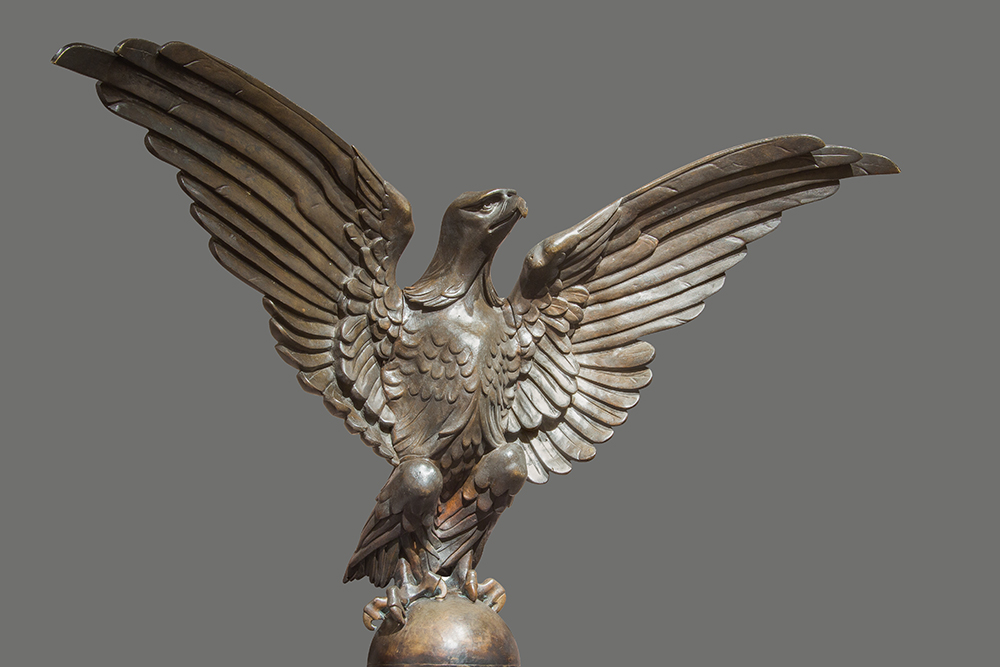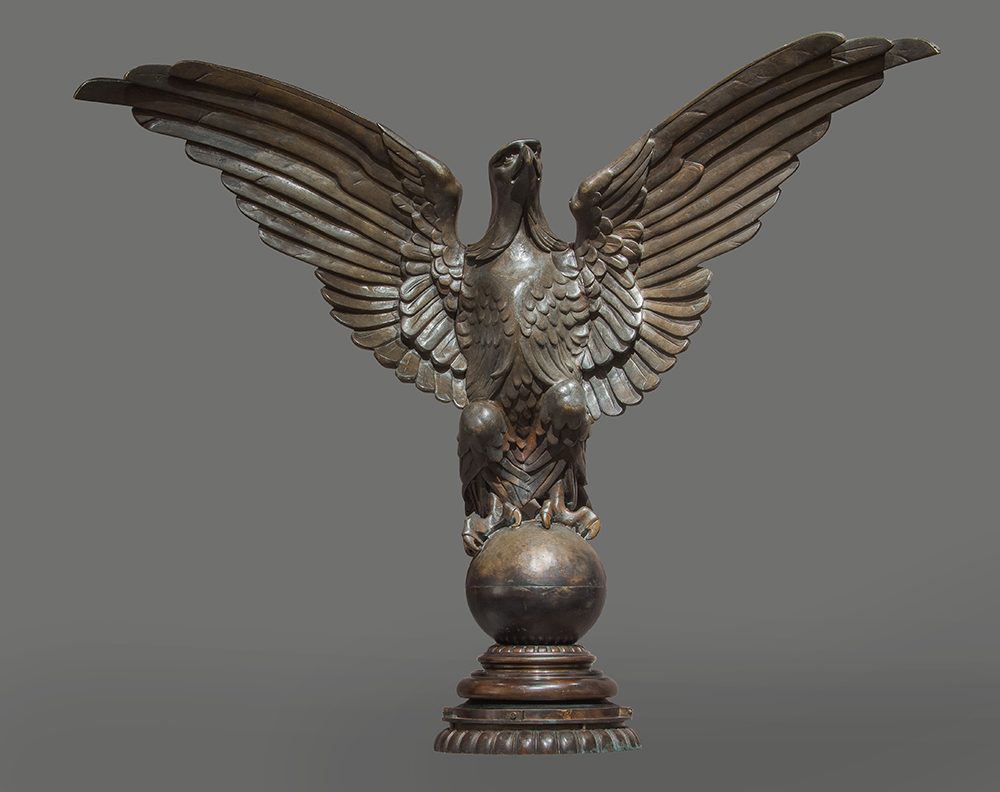


EUGÈNE EMMANUEL VIOLLET - LE - DUC (Paris 1814 - 1879 Lausanne), with
PLACIDE POUSSIELGUE - RUSAND (Paris 1824 - 1889 Paris)
Chef-modèle of the Eagle for the Lectern, Notre-Dame de Paris
Height: 31 ½ inches (80 cm)
Wingspan: 42 ½ inches (108 cm)
Depth: 15 inches (38.1 cm)
Diameter of the Base: 10 3/4 inches (27.3 cm)
1868
PROVENANCE:
Placide Poussielgue-Rusand, by descent
Private collection, France
PREPARATORY DRAWINGS:
Médiathèque de l’architecture et du patrimoine, inv. nos. PM043227 to PM043233
RELATED LITERATURE:
Viollet-le-Duc, exhibition catalogue, Paris, Galeries nationales du Grand Palais, 19 February - 5 May 1980, Paris, 1980, pp. 269, 271 nos. 435-438.
In April 1868 the Conseil de Fabrique of the Cathedral of Notre-Dame de Paris approved Viollet-le-Duc’s designs for a new bronze lectern to be erected in the choir to replace the previous lectern, which was deemed too “old fashioned” (*F1). Its execution was assigned to Placide Poussielgue-Rusand.i Our Eagle, formerly in the collection of the Poussielgue-Rusand family, is the chef-modèle for the eagle perched atop the Notre-Dame lectern. In Medieval times the eagle was seen as a symbol of Christ and His Divine Nature. The eagle also serves as the emblem of Saint John the Evangelist. Our bronze stands majestically, wings spread wide, with his head turned slightly upward. His gaze is direct and unflinching.
In bronze casting, a chef-modèle serves as the model from which subsequent sculptures are made. Perhaps Viollet-le-Duc and Poussielgue-Rusand had the idea of producing a deluxe edition of the eagle from our chef-modèle. Given the size and weight of the sculpture, it would have undoubtedly been too costly a project to pursue. Therefore, only two versions of the eagle are known—ours and the one on the top of the Notre-Dame lectern (fig. 1). Seven gouache studies for the lectern, signed Viollet-le-Duc and dated 1868, also survive (fig. 2). Formerly in the collection of the descendants of Poussielgue-Rusand, they are now in the Médiathèque de l’architecture et du Patrimoine.
Our chef-modèle is the only surviving sculptural example from the original design for this gothic revival masterpiece, as well as for the furnishing projects that completed Viollet-le-Duc’s major restoration campaigns at Notre-Dame de Paris.
Fig. 1. Viollet-Le-Duc, Lectern, Paris, Cathedral of Notre-Dame.
Fig. 2. Viollet-Le-Duc, Study for the Lectern of Notre-Dame Cathedral, gouache, Médiathèque de l’architecture et du Patrimoine, inv. no. PM043227
Eugène Viollet-le-Duc was born in Paris to a father who was a civil servant and a mother who hosted weekly salons attended by many of the leading intellectuals of the day, including Stendhal and Sainte-Beuve. Viollet-le-Duc participated in the barricading of Paris during the July Revolution of 1830 and, in general, rebelled against figures of authority. He refused to study at the École des Beaux Arts, preferring to apprentice himself to the architect Achille Leclère. During this time he was greatly influenced by the work and theories of the architect Henri Labrouste and, in 1836, Viollet-le-Duc travelled to Italy to study architecture, where he remained for a little over one year.
Upon his return to France, his interest in Gothic art and architecture led him to the atelier J.-B. Lassus, who mentored the young artist in the techniques of medieval architecture and archaeology. Together they worked on the restoration of Saint-Germain-l’Auxerrois (1838).
In 1839 the writer Prosper Mérimée, a good friend and inspector general of historic monuments in France, appointed Viollet-le-Duc to lead the restoration of the abbey church of La Madeleine in Vézelay (1840). Viollet-le-Duc would go on to work with Lassus on a number of restoration projects, including the Cathedral of Notre-Dame de Paris, beginning in 1845.
Apart from practical work in the restoration of historic edifices, Viollet-le-Duc was an architectural theoretician. He wrote extensively on the use of what he phrased "honest" materials, meaning that they should reflect the forms for which they were used. His theories may well derive from the writings of John Ruskin, who promoted the idea of the use of "honest" materials in architecture. However, Ruskin and Viollet-le-Duc were diametrically opposed in their theories of what constituted the appropriate restoration of an ancient building. Ruskin advocated for a renovation that returned an edifice to a state as close as possible to its original form. On the other hand, Viollet-le-Duc championed a restoration that, while retaining some of its original aspects, also created a building using both borrowed and "modern" architectural elements in order to create a homogenous whole that never really existed.
Viollet-le-Duc inspired later designers and architects in his application of the principles of Gothic architecture to the use of modern materials, such as iron. In later years his ideas were reflected by such Art Nouveau artists and designers such as Hector Guimard, Victor Horta, and Antoni Gaudi. The American architects Louis Sullivan (Boston, MA 1856-1924 Chicago, IL) and Frank Lloyd Wright (Richland Center, WI 1867-1959 Phoenix, AZ) also synthesized the theories of Viollet-le-Duc into their work.
During the Second Empire Viollet-le-Duc collaborated with three important orfèvres (goldsmiths) to produce religious objects for which he was commissioned. They were Louis Bachelet (active Paris 1851-1867), Placide Poussielgue-Rusand and Jean-Alexandre Chertier (Paris 1824-1890 Paris). Although all three goldsmiths worked with Viollet-le-Duc specifically on liturgical works of art, it was Poussielgue-Rusand who was the most prestigious and produced the majority of Le Duc's important pieces.
After having gained enormous recognition, for his restorations, including the Basilica of St. Mary Magdalene, Vézelay; Notre-Dame de Paris; Sainte-Chapelle, Paris; the Basilica of St. Denis, near Paris; Mont Saint-Michel; as well as the fortified city of Carcassonne, and the castles of Roquetaillade and Pierrefonds, Viollet-le-Duc gave up his official positions and moved to Lausanne, Switzerland. There, he designed and constructed his own chateau and produced a series of beautifully vibrant watercolors of the Swiss alps, a subject on which he was well-versed, having been a founding member of the French Alpine Club.
FOOTNOTES:
*F1: Registre des délibérations du Conseil de Fabrique, 27 April 1868, t. 1, p. 83.


